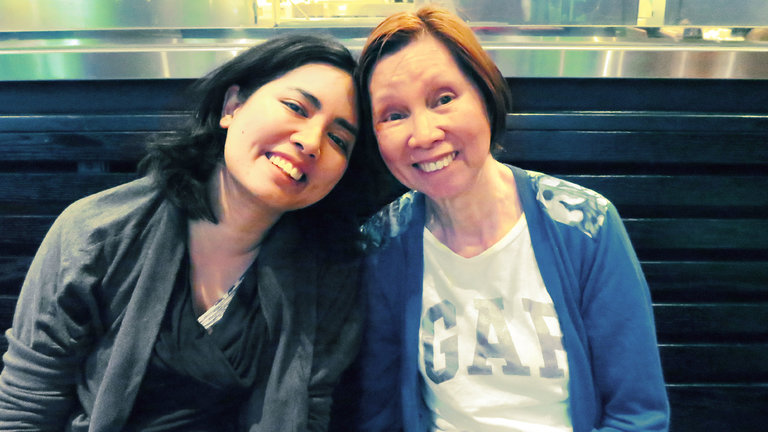PSP on the front page of the New York Times!
Oct 21, 2016 By Lucas Metherall
Sylvia Rupani-Smith, long-time friend of CurePSP and strong advocate for the cause, brings PSP awareness to the mainstream media with her article about her mother’s diagnosis and journey with PSP being published in the New York Times, October 20, 2016
See the full article below.
The Falls Were Bad. The Diagnosis Was Worse.

“She was just standing there,” my dad told my sister, by way of explanation, “and she fell.” My mom managed a small smile, with her big swollen lip, like it was her fault, my sister told me. The three of them were living in a small apartment in Tokyo at the time. This was five years ago, in 2011, the year my mom started falling down.
My Filipina mother, Betty, age 72 and all of 88 pounds at the time, had raised five children in Japan and was endlessly active, hopping on her bicycle to do errands or deliver delicious homemade food to my high school, or hurrying to the subway to spend time with close friends. It was unlike her to lose control of anything, especially her balance.
So naturally we were confused when she had a very bad fall later that year, during a wedding in Las Vegas. And, two years later, when she banged her head on a dresser drawer while on vacation in Atlantic City, requiring a visit to an emergency room to get stitches.
She insisted she was fine, and we chalked it up to inner-ear problems, which she’d had for years. But soon things escalated and we made it a point to keep a watchful eye over our mother, wondering when she might fall again, wondering if one of us would be there to catch her when she did.
When my mother came to visit me and two of my siblings in New York in the spring of 2013, we decided it was time to consult a neurologist, who put her through a battery of tests over several visits. In one, the doctor lifted her finger up in front of my mother’s face and asked her to stare at the tip of it, a task that proved difficult. “Her eyes couldn’t stay fixated on my finger,” the doctor told me. “Instead, they moved in a quick motion horizontally away from my finger, then quickly returned back.”
My mother’s memory was still solid: She could easily cite back three words (“desk,” “green” and “camel”) the doctor asked her to remember between clinic visits. But that finger test, along with other signs, led to a diagnosis: P.S.P.
P.S.P., or progressive supranuclear palsy, is a rare brain disease that affects only five to six people per 100,000 and has no proven medical treatment and no cure. There’s not even much about it on the internet. The actor Dudley Moore, of the movie “Arthur,” had the disease. Many people presumed he was drunk when they’d see him staggering, but he was actually losing his balance, often, because of the condition.
In some ways we felt lucky: We got a diagnosis. Because most physicians have little or no experience with P.S.P., and because many of the symptoms overlap with other neurological and movement disorders, many people with the illness end up getting wrong diagnoses of Parkinson’s disease or Alzheimer’s.
“We went to 19 different doctors and neurologists over seven years. None of them even suspected she had P.S.P.,” Mubina Schroeder, a professor at Molloy College in Long Island, said of her mother, who had been told by doctors she had Alzheimer’s. It wasn’t until one doctor picked up on a characteristic sign of P.S.P. — her astonished facial expression — that she was told, “She looks like my mother-in-law. She has P.S.P.”
The condition can present with multiple symptoms: loss of balance, swallowing problems, slurred speech, an inability to walk or talk. Difficulty moving the eyes, especially up and down, and poor bladder control are also common. Depression, memory and thinking problems or loss of inhibition can also occur. All get worse with time.
Dr. Lawrence Honig, a professor of neurology at Columbia University, told me, “Unfortunately, at this time, we have no proven treatments to affect the course of the disease.” Some patients get small benefits from carbidopa/levodopa, a combination of drugs prescribed for patients with Parkinson’s disease, but most don’t. Various drugs can be used to manage symptoms like drooling, urinary frequency, agitation, insomnia or depression, and “thickeners” can be added to drinks to make them easier to swallow, he said.
“The biggest takeaway is to have patience,” said the actress and writer Kathryn Leigh Scott, who wrote a book about her late husband’s struggles with the disease, called “Last Dance at the Savoy.” “P.S.P. has no treatment, no cure. It’s important to enjoy every precious moment.”
My parents now live in Las Vegas, along with one of my sisters and her husband, who moved from Brooklyn to be with her and help provide round-the-clock care. My mom is still quite sharp mentally. But in the five years since her first fall, she can no longer walk, and no longer talk, and she is now under 70 pounds. She spends her days in a remote-controlled operated bed, watching TV, playing catch with a ball or video games on an iPad.
I recently visited for a month and helped out with shifts in caring for my mom. I found myself doing everything for her, the way she had done everything for me when I was a kid: feeding her, giving her medicine, brushing her hair. She assists any way she is able, turning her body when we ask, opening her mouth as wide as she can when prompted.
I also found myself cuddling up to her in her bed like I used to when I was younger. I envy those who have moms who can talk and walk. But I am lucky to be able to spend time with my mom for as long as I am able.
©2016 The New York Times

.jpg)


.png)